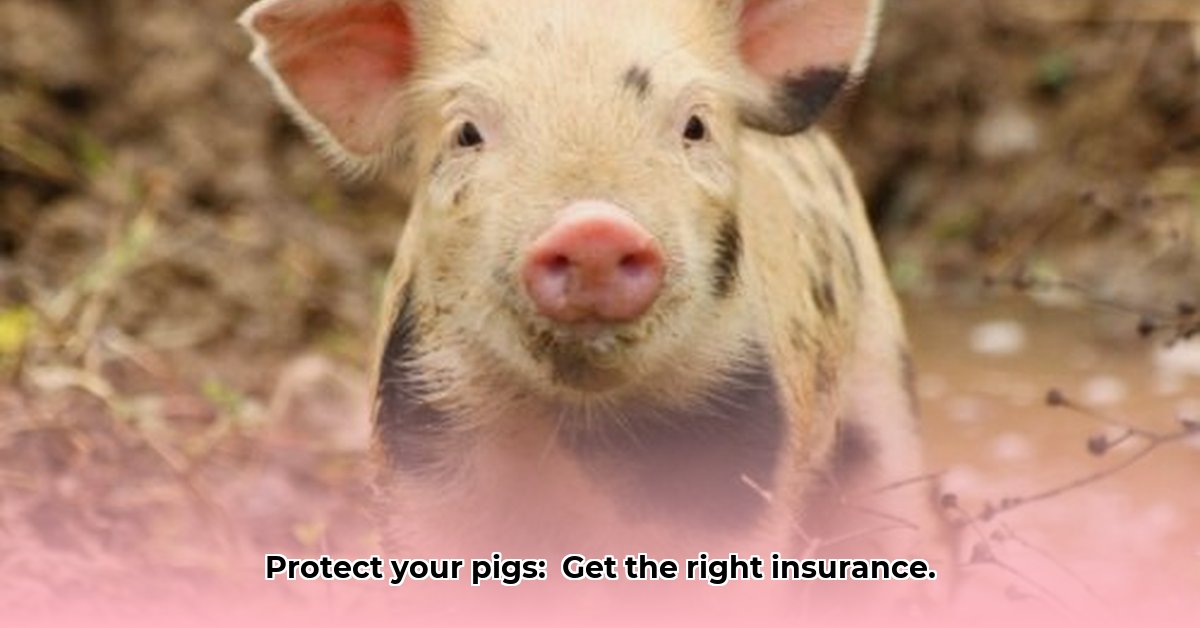
Running a pig farm is demanding, and unforeseen events can severely impact profitability. Disease outbreaks, accidents, and adverse weather can quickly deplete resources. This guide provides a clear path to securing the right insurance for your piggery, covering various policy types, risk assessment, and actionable steps to protect your investment and livelihood. Understanding your risks is the first step towards building a robust financial safety net for your sustainable swine farm.
Piggery Insurance: A Financial Safety Net for Sustainable Swine Farms
Raising pigs requires significant investment and dedication. Unexpected events, however, can undermine your efforts. Piggery insurance acts as a financial safety net, protecting your farm from various risks and ensuring its long-term viability. This guide empowers you to navigate the complexities of pig insurance, enabling you to choose the optimal coverage for your operation.
Understanding the Risks: Identifying Vulnerabilities in Your Piggery Operation
Successful pig farming requires proactive risk management. Several factors can significantly impact your farm's financial health:
- Disease Outbreaks: Highly contagious diseases can decimate your herd, leading to substantial financial losses. (Disease outbreaks can lead to significant losses in herd size and income).
- Weather Events: Extreme weather, such as storms or floods, can damage your facilities and disrupt operations. (Severe weather can cause structural damage and operational disruptions).
- Accidents: Accidents involving your employees or visitors can lead to costly lawsuits and legal battles. (Accidents can result in worker injuries, property damage, and litigation).
- Market Fluctuations: Changes in pork prices and feed costs can impact profitability. (Market volatility can significantly affect your revenue and expenses).
- Regulatory Non-Compliance: Failure to adhere to environmental regulations can result in hefty fines. (Environmental violations can lead to severe penalties and legal repercussions).
A comprehensive understanding of these risks is the cornerstone of effective insurance planning.
Types of Piggery Insurance: Building Your Comprehensive Protection Plan
Several insurance types offer tailored protection for piggeries:
Livestock Mortality Insurance: This crucial policy covers losses due to pig deaths from disease, accidents, or natural causes. (This safeguards your investment in your livestock by covering deaths from various causes).
Property Insurance: This protects your physical assets, including barns, equipment, and other structures, against damage from fire, storms, or other unforeseen events. (This protects your physical assets from damage or loss caused by various events).
Liability Insurance: This protects you from lawsuits stemming from accidents involving employees or visitors on your farm. (This provides protection against potential lawsuits arising from accidents or incidents on your farm).
Business Interruption Insurance: This covers lost income due to temporary shutdowns caused by disease outbreaks, severe weather, or other disruptive events. (This helps maintain your financial stability during periods of interrupted operation).
Livestock Gross Margin (LGM) Insurance: This unique policy protects against market price swings and feed cost fluctuations. This is extremely helpful for reducing the impact of price changes on your overall profitability. 1
Assessing Your Risks: A Personalized Risk Evaluation Strategy
Before selecting a policy, conduct a thorough risk assessment specific to your farm:
Farm Size and Location: Larger farms generally face higher potential losses, requiring broader coverage. Location influences risk exposure to specific diseases or weather events.
Biosecurity Measures: Robust biosecurity measures significantly reduce the likelihood of disease outbreaks, potentially leading to lower premiums. (Strong biosecurity protocols are often rewarded with lower insurance premiums.)
Regulatory Compliance: Strict adherence to environmental regulations demonstrates responsible farming and minimizes potential fines. (Compliance minimizes risk associated with regulatory non-compliance).
Worker Safety Practices: Comprehensive safety programs reduce worker injuries, leading to lower liability risks and potentially favorable insurance costs. (Prioritizing worker safety can significantly reduce liability risks and associated costs).
Choosing the Right Policy: Steps to Secure Optimal Swine Farm Coverage
Selecting the perfect insurance plan involves careful planning:
Shop Around: Obtain quotes from multiple insurers. Don't just focus on price; compare coverage details, limits, and exclusions.
Analyze Policy Details: Scrutinize policy language, paying close attention to what is and isn't covered. (Thorough analysis helps to avoid unpleasant surprises later on).
Verify Coverage Limits: Ensure coverage limits are sufficient to replace your assets and cover potential losses. (Adequate coverage limits prevent financial hardship in the event of an incident).
Consult an Insurance Specialist: An experienced agent can provide guidance and tailor coverage to your farm's specific needs.
Regular Review: Periodically review your coverage to ensure it aligns with your evolving needs.
Sustainable Practices: Lowering Risks and Premiums
Sustainable farming practices benefit both your environment and your bottom line. Insurers often reward farms demonstrating a commitment to responsible environmental stewardship. This includes improved waste management, robust biosecurity protocols, and other sustainable practices, lowering your risk profile and potentially impacting your premium.
Government Aid and Support: Exploring Available Resources
Investigate government programs and resources tailored to swine farmers. Many provide subsidized insurance or financial support programs that can enhance the resilience of your farm.
A Final Word: Insurance as a Strategic Investment
View piggery insurance not as an expense but as a strategic investment safeguarding your farm's future. By choosing the right coverage and practicing sound risk management, you can protect your financial stability and ensure the long-term success of your operation.